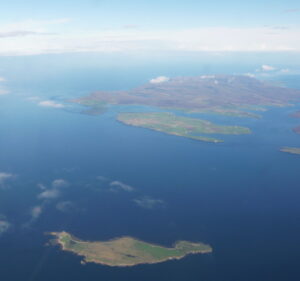
I ventured over to Caithness last night. The short sea crossing made me think about horizons and boundaries: real and perceived. Can we really separate them?
I was less than 50 miles away from home, but it seemed like another world. I wonder how it was perceived by the Mesolithic communities who made Orkney their home? People ask me whether the inhabitants of Mesolithic Orkney lived here year round. Of course, the short answer is that we don’t know – but that is not very satisfactory; perhaps it is more useful to explore the possibilities.
The first problem is that the Mesolithic lasted for a very, very long time – around 5000 years – and so it is likely that practices changed throughout that period. The second problem is that we don’t know how many people lived here – indeed the population of Orkney is likely to have fluctuated depending on climate, resources, disease, and whim. The third problem is that the Mesolithic community is likely to have been fluid – ‘families’ may not have stuck together all the time, groups may have split from time to time only to come together again after a month, a season, a year, or several years.
I think it is likely that there were resources in Orkney on a year round basis. Fresh water, firewood and driftwood for fuel, food (fish, meat, shellfish, eggs, nuts, seeds, roots and berries) – those who knew how to harvest the land carefully would find what they needed. However, hunter-gatherers do need to move around a territory in order to maintain supplies for future years and, while Orkney provides a nice compact unit, it would not support many people for very long if there were no management of the natural resources.
It is not just a question of management though; it is also a question of perception and understanding. In many ways our home-ranges have diminished as transport has got better. I think twice about crossing Orkney from Kirkwall to go to the cinema club in Stromness and it was just the same when I lived in Edinburgh – we choose school, shops and services within easy reach of where we live. All our basic needs can be fulfilled close to home. Mesolithic communities had a home territory that covered a wider area and they were familiar with all parts of it. They had to be in order to survive. If resources failed in one place, they had to be able to navigate to another and know how to obtain what they needed, even after an absence of several years. So, the Mesolithic home territory had to be large enough to provide for all eventualities, with some flexibility thrown in, to allow for fluctuations in weather and population.
I think it likely that those lived in Orkney also considered the moors and hills of Caithness as familiar, home, ground. It seems very different to us, and the boat-ride emphasises that feeling of dislocation. The way in which we travel today is always somehow sterile – whether by car, ferry or plane, we are often alone and disconnected. Travellers in the past tended to move with, and among, their own people. And, while Caithness is, indeed, very different to Orkney it complements it perfectly. Orkney and Caithness together make a formidable territory. So, I’m not surprised that we are finding increasing evidence for Mesolithic settlement on both sides of the Pentland Firth.
It wasn’t ever an easy crossing, but for those who saw themselves as part of the natural world and treated it with respect, it wasn’t a great obstacle. The boundary today is mental, more than physical and it is somehow strange that communities so near, can, yet, seem so far away. We manage our world so differently to our predecessors eight thousand years ago, but it is not always true to say that our horizons have increased.
You must be logged in to post a comment.